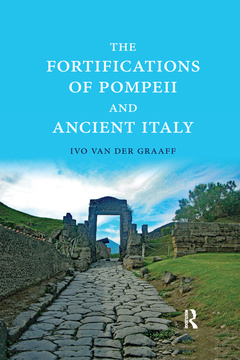The Fortifications of Pompeii and Ancient Italy
Auteur : Van der Graaff Ivo

The fortifications of Pompeii stand as the ancient city?s largest, oldest, and best preserved public monument. Over its 700-year history, Pompeii invested significant amounts of money, resources, and labor into (re)building, maintaining, and upgrading the walls. Each intervention on the fortifications marked a pivotal event of social and political change, signaling dramatic shifts in Pompeii?s urban, social, and architectural framework. Although the defenses had a clear military role, their design, construction materials, and aesthetics reflect the political, social, and urban development of the city. Their fate was intertwined with that of Pompeii.
This study redefines Pompeii?s fortifications as a central monument that physically and symbolically shaped the city. It considers the internal and external forces that morphed their appearance and traces how the fortifications served to foster a sense of community. The city wall emerges as a dynamic, ideologically freighted monument that was fundamental to the image and identity of Pompeii. The book is a unique narrative of the social and urban development of the city from foundation to the eruption of Vesuvius, through the lens of the public building most critical to its independence and survival.
Contents;List of Figures ;List of Color Plates;Acknowledgements;Introduction ;1 Prolegomena to the City Walls of Pompeii;The city walls and the urbanization of Pompeii;Excavating the fortifications;2 Defense and the Genesis of the Community;The fortifications and the city;The Orthostat wall;The Altstadt as nucleus to Pompeii;Walls, gods, politics and the early community;3 A New Enceinte for a New City;Reconstructing the Samnite Circuit;Achieving an ornamental effect;Gates and towers in the first Samnite circuit;Upgrading the defenses;Emphasizing the transition through the fortifications;Reaching new heights: opus incertum and the next phase of construction;New elements to old gates;The towers;4 Establishing an Image for Samnite Pompeii;Calibrating the image of the expanding city;Building materials and the image of Pompeii;Samnite Pompeii defines its image;Fortifications and the urban network;The image of the high Samnite city;Patronage and display at the walls;Naming the fortifications;5 The Fortifications and the Roman Colony ;The walls of the colony;Reconstructing the walls;The development of the gates;Change and continuity in the towers;The changing role of the fortifications;6 The Fortifications and Roman Pompeii;Adjusting the civic image;The significance of an entertainment district: the fortifications, the amphitheater, and the palaestra;Claiming public land;Fortifications and the tomb: dialogues in social order;City walls in the domestic sphere: reflections of urban and social ideals;7 The Fortifications of Pompeii in their Broader Context;Military tactics influences and design;The closest parallel to the Pompeian circuit;Masonry, fortifications, and the definition of a city;Polychrome masonry and city walls;Towers and the ornamentation of the city;Patronage and the concept of the city;8 Fortifications and Religion;The development of Venus Pompeiana;Religion, fortifications, and identity outside of Pompeii;Patronage, religion and power at the gates;Glossary ;Bibliography ;Index
Ivo van der Graaff is Associate Professor of Art History at the University of New Hampshire, Durham. He earned his MA in Mediterranean Archaeology from the University of Amsterdam and his PhD in Art History from the University of Texas at Austin, with a focus on Greek and Roman Art and Architecture. Dr. van der Graaff has participated in archaeological research projects in the Netherlands, Belgium, Greece, and Italy. He co-directs and collaborates on projects examining the ancient Bay of Naples and Etruria.
Date de parution : 09-2020
15.6x23.4 cm
Date de parution : 09-2018
15.6x23.4 cm
Mots-clés :
Opus Incertum; Porta Vesuvio; century; Late Fourth Century Bce; bce; Caecilius Jucundus; opus; Porta Marina; incertum; Tuff Masonry; porta; Triangular Forum; vesuvio; Van Der Graaff; marina; Doric Frieze; late; Ashlar Masonry; fourth; Sarno River; curtain; Tower II; Ivo van der Graaff; Tuff Blocks; Samnite Period; Doric Temple; Drainage Spouts; Construction Seams; Plaster Veneer; Opus Quadratum; Polygonal Masonry; Gate Court; Servian Wall; Regiones III; Campan Ella; Water Falling



